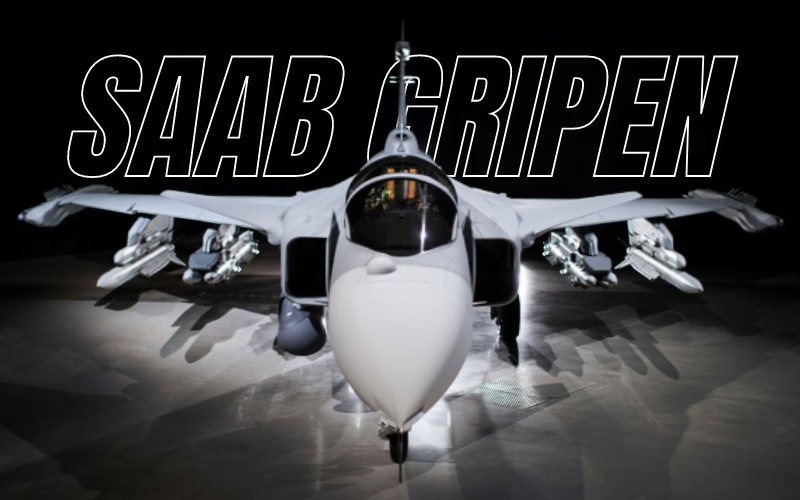With countries bidding for India’s enormous 114 Multi-Role Fighter Aircraft contract, the Indian Air Force’s search for the next multirole aircraft is escalating. While the Rafale is frequently seen as the frontrunner in this competition, many experts regard the SAAB Gripen as the dark horse.
Over the last few years, India has been hunting for a 4.5 generation aircraft as part of its Air Force modernization plan. The IAF’s fighter force is dwindling, forcing this MMRCA 2.0 buy.
The new fighters will replace the MiG-21s, Mirage 2000s, and Jaguars that are currently in service. The IAF currently operates 32 squadrons out of a sanctioned strength of 42. Lockheed Martin’s F/A-18 and F-21, Dassault Rafale’s MiG-35 and Sukhoi-35, Eurofighter Typhoon, and SAAB Gripen are among the major contenders for the lucrative contract.
According to a recent study performed by EurAsian Times, the SAAB Gripen Rafale is the preferred aircraft for the deal and is chosen by several defence specialists. The SAAB Gripen, on the other hand, may be viewed as a cheaper alternative to the French Rafales.
The Gripen fighter plane was also one of six contenders for the last MMRCA agreement for 126 fighters, which saw India purchase 36 Rafale jets in flyaway condition.
SAAB has been campaigning hard for this contract. In June 2021, Swedish defence minister Peter Hultqvist made a forceful pitch to India for the new Swedish fighter jet, emphasising that the contract was “100% supported by his administration.”
India’s Prime Minister Narendra Modi and his Swedish counterpart Stefan Lofven held a video conference on March 5, 2021, during which the two leaders are alleged to have discussed critical matters such as the sale of Gripen fighter planes. For IAF, the business is promoting its newest model, the Gripen E.
The single-engine Gripen has previously been criticised for its poor performance. The Gripen E has more pylons and fuel capacity than its predecessor, but this is offset by a more powerful engine, the GE F414, which replaces the F404 in prior generations.
“The SAAB Gripen was not completely developed during the MMRCA tender,” Air Marshal Pranab Kumar Barbora (Retd) said of the Gripen’s performance in MMRCA. We conducted the tests, and the jet did not perform up to our expectations. They would have undoubtedly tightened up any loose ends now that they have had enough time — over 15 years — giving the Gripen a fair shot in the game.
The Gripen E may resemble prior Gripen models in appearance and feel, but it marks such a significant upgrade that SAAB considered giving it a new designation. The tradition of the original Gripen A single-seat and B two-seat versions is carried on with the E-Series.
EW Technologies of the Future
Electronic warfare has become a crucial aspect of today’s battle scene. It’s come a long way since the days of simple radio communication jamming. Air forces all around the world are attempting to manipulate and potentially control the entire electromagnetic spectrum in order to gain an advantage in combat.
The EW suite is said to be easily incorporated into every Gripen aircraft, allowing pilots to act freely without the need for a specialised EW aircraft. Gripen E was also the first fighter jet with an AESA radar mounted on a rotating swashplate or repositioner.
This increases the range of the AESA and allows the pilot to aim at a target without having to point it. This also lowers the chances of an adversary firing a missile at the plane. The pilot can launch a missile beyond visible range and then turn 90 degrees using the swashplate. It also delivers missile firing updates in mid-flight. When combined with the Meteor, this provides a huge tactical advantage.
Because SAAB feels that as software and hardware technology progresses, stealth aircraft will become more visible to radar systems, the Gripen E does not incorporate any geometric stealthy design features.
The manufacturer claimed to have installed a digital shield on the plane. The goal was to constantly and dynamically create and improve the system in order to meet recognised threats. The EWS, which is combined with a 360-degree spherical missile approach warning system, combines active and passive systems to help protect the plane.
Given India’s extensive borders, which necessitate intensive surveillance and security in the face of ongoing security concerns, a fighter that can spend less time in the hangar is surely required. The Gripen has an advantage in this aspect because it does not require a complex infrastructure to operate.
In addition, a small team of technicians can change the Gripen engine in less than an hour, fuelling takes around 10 minutes, and the fighter can be ready for the next air-to-air mission in ten minutes.
Gripen – A Cost-Effective Option for India?
SAAB has presented a broad pre-tender proposal for an Indian order of 114 fighter jets, saying that its Gripen E single-engine fighter is half the price of the Rafale. According to SAAB, India is planning to conduct a global tender in the first half of this year.
The Rafale is a larger, twin-engined aircraft with a higher price tag, but SAAB touts its single-engine aircraft as a much more affordable option. SAAB also provided its previous year’s price offer to Finland, which it used to substantiate its claim of a significant price advantage.
“The Gripen will not be at a disadvantage owing to being a single-engine aircraft,” Barbora previously told EurAsian Times. This is because technology has advanced to the point that the aircraft’s reliability factor has increased by orders of magnitude.”
This SAAB Gripen armament system is identical in capability to the one purchased by India as part of the 7.8 billion Euro Rafale aircraft deal. Among them are the Meteor, IRIS-T, KEPD-350 Taurus, and Spear. Furthermore, when compared to its competitors, the Gripen E appears to have been developed to harvest maximum performance without bending the cost curve.
